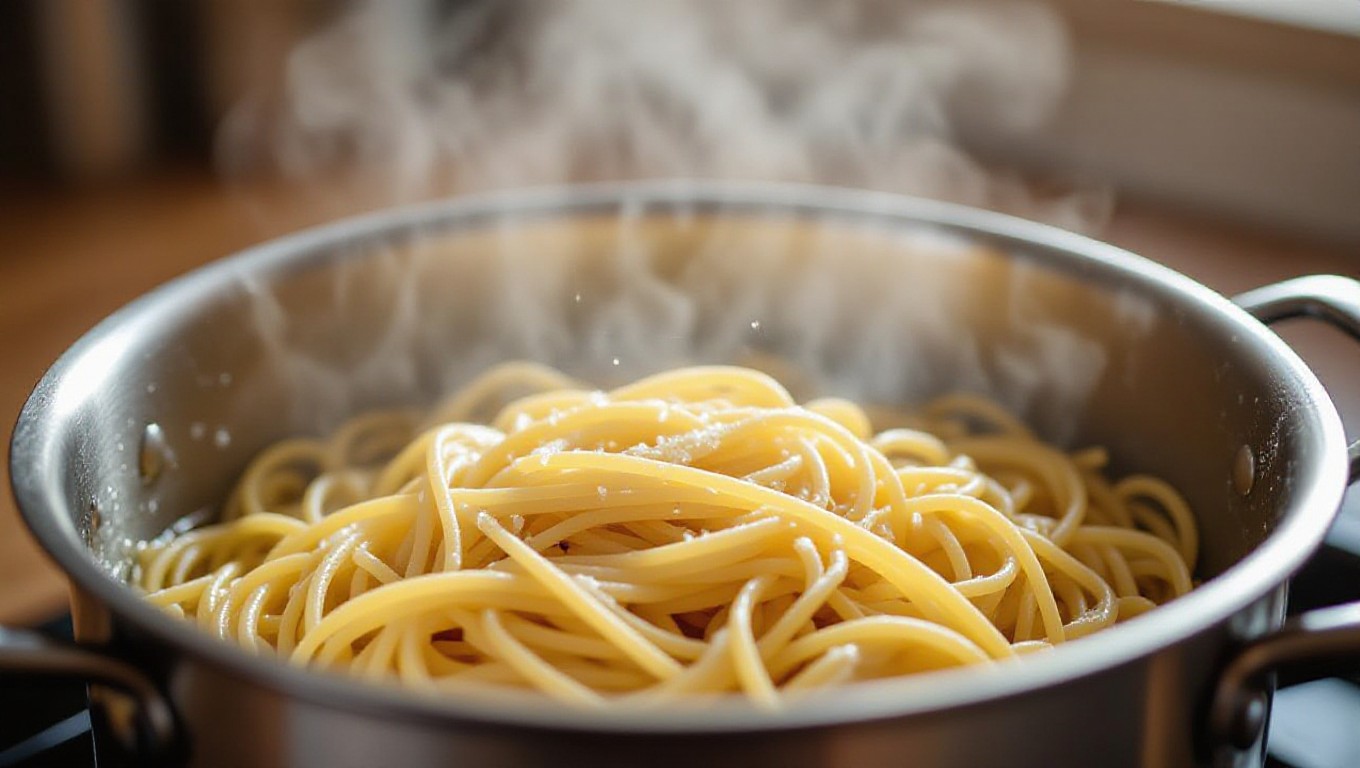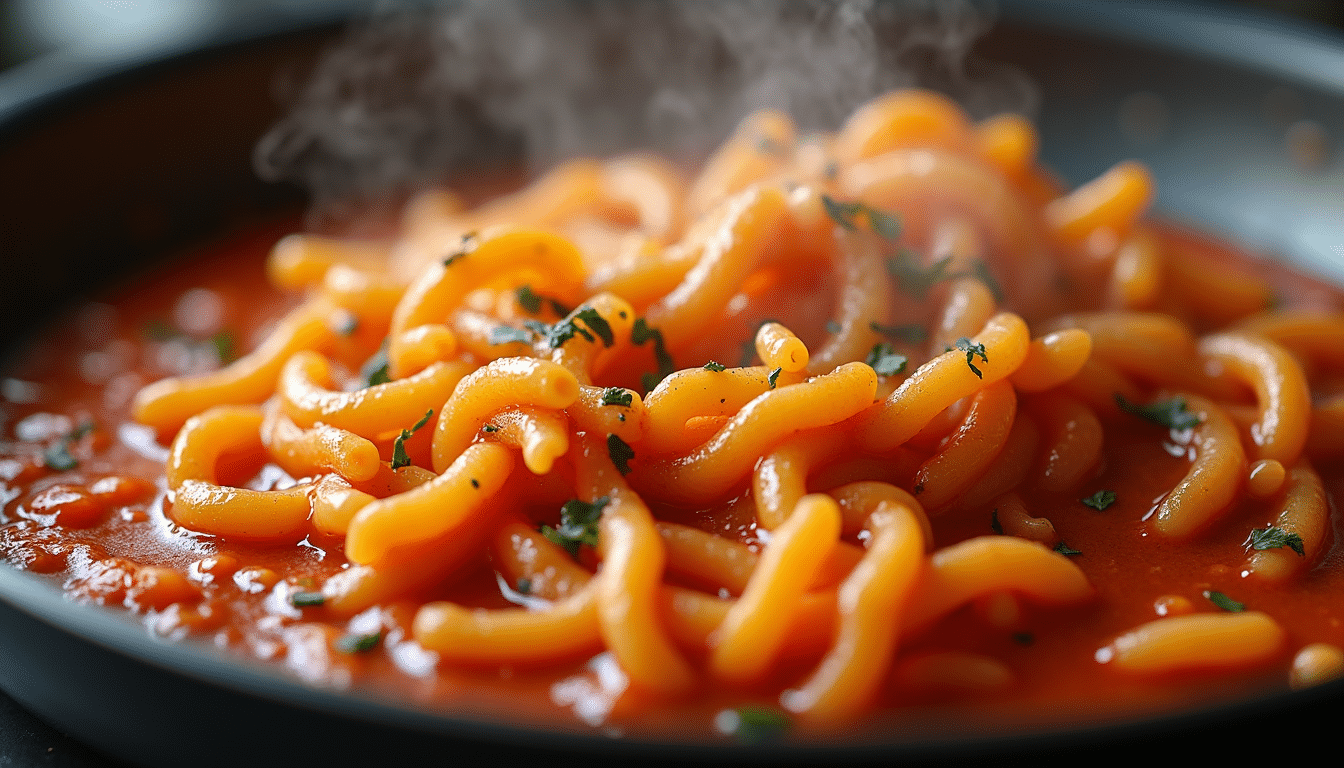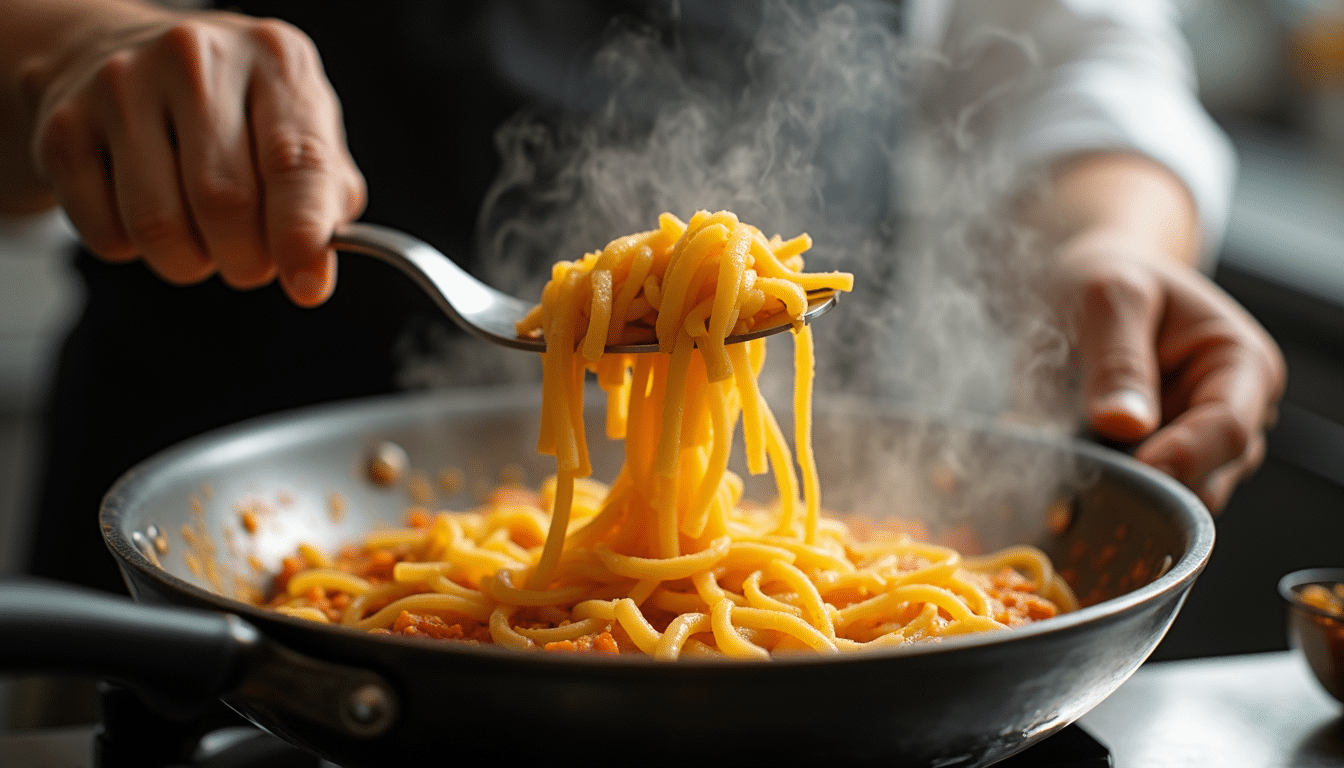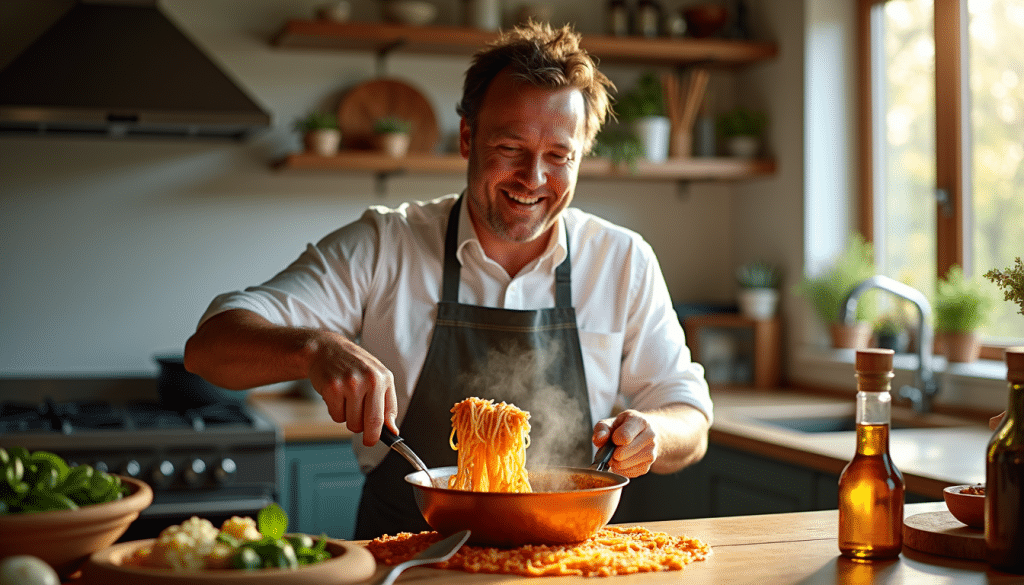Over a bubbling pot, it’s easy to assume the cooking stops when the timer beeps, but draining every drop of water is actually the most dangerous habit in your kitchen. There’s a massive gap between dry, sad noodles and the glossy, clinging texture Jamie Oliver serves up. It’s not just about the ingredients – it’s about the marriage in the pan. You’re going to learn exactly how to emulsify starchy water with fat to create a sauce that actually sticks. Get ready to finally fix your pasta game.
The Foundation – What’s the Deal with Pasta Texture?
Getting that texture right is the difference between a sad bowl of mush and a meal that sings. Jamie always emphasizes that pasta isn’t just a vehicle for sauce – it’s the main event, so it needs to have a backbone. You want a firm, slightly resistant center that gives way with a satisfying snap when you bite down, not something that dissolves on your tongue like baby food.
This is about respect for the grain and understanding that the starch needs to work *for* you. It’s about creating that beautiful friction against the sauce that coats every strand instead of sliding right off. If your pasta is too soft, you lose the contrast, and the whole dish becomes one monotone texture that gets boring after three bites.
How to Choose the Right Pasta
Don’t just grab the cheapest blue box on the shelf because the surface texture changes everything. You need to look for dried pasta that feels rough to the touch or says “bronze-die cut” on the package. This means the dough was pushed through bronze molds, creating a rough, sandpaper-like surface that grabs onto your sauce like velcro. Smooth, shiny pasta made with Teflon dies might look pretty, but your sauce will slip right off into a puddle at the bottom of the bowl, leaving you with dry noodles and a flavorless bite.

Shape matters just as much as quality when you’re pairing it with your sauce. You wouldn’t put a heavy ragu on delicate angel hair because it would crush the noodles, just like a light olive oil dressing gets lost in a giant rigatoni tube. Match the weight of the pasta to the weight of the sauce – think shells and ears for chunky vegetable sauces that need catching, and long, flat ribbons like tagliatelle for creamy, emulsified sauces that need plenty of surface area to cling to.
The Secret to Perfectly Cooked Noodles
Most home cooks are terrified of salt, but if your water doesn’t taste like the Mediterranean sea, you’ve already lost the battle before the pasta hits the pot. You need a rolling boil in a large pot – give those noodles room to dance – and then you have to ignore the cooking time on the packet by at least two minutes. If the box says ten minutes, you’re pulling it out at eight, because the real cooking finishes in the pan with the sauce, where the pasta absorbs flavor instead of just water.
Testing is the only way to know for sure, so fish a piece out and bite into it. You’re looking for a tiny white chalky ring right in the center of the cross-section – that’s the sweet spot where it’s technically undercooked but ready to transfer. If you cook it until it’s perfectly soft in the water, it’ll be overcooked mush by the time you’ve tossed it with your sauce, ruining that signature Jamie Oliver texture we’re chasing.
Saving a mug of that cloudy, starchy cooking water is the single most important step you can take. Before you drain the pot – or better yet, use tongs to transfer the pasta directly – scoop out a cup of the water because that liquid gold is the emulsifier that binds oil and water into a glossy, creamy coating. When you toss the undercooked pasta into the pan with your sauce and a splash of that water, the starch thickens everything up as it bubbles away, finishing the cooking process and marrying the flavors together in those final sixty seconds.
The Sauce Connection – Jamie’s Go-To Tips for Sauces
You might assume the sauce is just a tasty blanket you throw over the noodles at the very end, but that’s actually where most home cooks lose the plot because the sauce and pasta need to become one entity rather than two separate things on a plate. It’s all about the marriage in the pan. If you drain your pasta bone-dry and dump a ladle of red sauce on top, it slides right off, leaving you with a puddle of red water at the bottom of the bowl. Instead, you have to toss the pasta directly into the skillet while it’s still dripping wet. This technique relies heavily on emulsification, where the agitation of tossing combines the fat in the sauce with the starch on the noodles to create a creamy, clinging texture that refuses to separate.

Jamie always emphasizes that the magic happens in that final sixty seconds of high-heat tossing. You’re looking for a specific sound – a wet, sloppy slap against the sides of the pan that tells you the consistency is perfect. If it sounds dry or frying, you’ve gone too far. Check these specific cues to know you’ve nailed that signature Jamie Oliver pasta sauce consistency:
- Watch for the glossy sheen that appears when the oil and water bind perfectly.
- Ensure the sauce clings to the pasta without sliding off, achieving the perfect pasta texture.
- Listen for the “slurp” sound when tossing, indicating enough moisture is present.
- Taste a noodle to ensure the flavor has absorbed, learning how to cook pasta like Jamie Oliver.
Any excess liquid should evaporate just as the pasta hits perfectly al dente.
My Favorite Sauces to Pair with Pasta
It’s easy to grab whatever box is in the pantry and assume it’ll work with whatever you’re simmering, but shape is actually an engineering choice, not just an aesthetic one. A heavy, chunky bolognese has absolutely no business sliding off a strand of spaghetti – it just falls to the bottom and leaves you eating plain noodles. For those rich, meaty sauces, you need something with structural integrity like rigatoni or shells that act like little scoops to capture the good stuff. Tube shapes capture sauce inside, ensuring every bite is balanced.
On the flip side, delicate, oil-based sauces like a classic aglio e olio or a silky carbonara need long strands to coat evenly without getting lost in nooks and crannies. Spaghetti or linguine provides that long surface area for the emulsion to cling to. If you are making a pesto, use something twisted like fusilli or trofie – the herbal paste grips the twists so you get that punch of basil in every mouthful without it clumping up.
Why Fresh Ingredients Matter
Buying expensive imported ingredients isn’t the point here, but believing that a jar of grey, dried basil from 2019 can compete with a handful of fresh leaves is a mistake that kills your dish before you even turn on the stove. Fresh herbs contain volatile oils that evaporate quickly with heat. That is why you see Jamie tearing basil or parsley over the dish right at the very end – the residual heat releases the aroma without cooking out the flavor. Using fresh, vibrant herbs adds a grassy, peppery brightness that cuts through rich fats and heavy carbs.
The same logic applies to your base. While good canned tomatoes are a pantry staple – and totally fine for slow-cooked ragus – a quick weeknight pasta sauce transforms when you use fresh cherry tomatoes that burst in the pan. The acidity is different. It’s sharper, sweeter, and feels lighter on the tongue. When you use high-quality seasonal produce, you don’t need to hide behind heavy creams or excessive salt because the ingredients speak for themselves.

Don’t overlook the cheese either, because that bag of pre-grated stuff is coated in potato starch to keep it from clumping, which is exactly what ruins your sauce’s texture. It creates a grainy, gritty mouthfeel instead of melting into a smooth cream. You have to grate your parmesan or pecorino fresh from the block directly over the pan. The difference in meltability is night and day. Plus, the salty kick of fresh cheese acts as a seasoning agent, binding with that starchy water to create a savory coating that feels luxurious without being heavy.
Timing is Everything – How to Get It All Just Right
Syncing Up Your Pasta and Sauce
You’ve got two clocks ticking at once here, and managing them is the difference between a sad, sticky clump and a glossy masterpiece. Jamie’s golden rule is that the sauce should always wait for the pasta, never the other way around. Get your ragù, carbonara base, or simple tomato basil sauce bubbling away gently – or completely finished – before you even think about dropping the pasta into that salted water.
If your sauce is ready five minutes early, that’s fine, just turn the heat off and let it hang out. But if your pasta is ready and the sauce isn’t? Game over. The starch sets, the strands stick, and you lose that magical ability to marry the two together. By having the sauce sitting ready in a wide pan, you eliminate the panic and ensure you can transfer the pasta the second it hits that perfect texture.
Avoiding That Overcooked Disaster
Ignore the cooking time printed on the packet – treating those numbers as gospel is the quickest way to ruin dinner. Manufacturers often overestimate the time to ensure the pasta is soft, but soft isn’t what we’re chasing here. Instead, start fishing out a strand to taste about two minutes before the suggested time is up.
You’re looking for resistance. Not a raw crunch that gets stuck in your molars, but a definite firmness in the center that fights back against your teeth just a little bit. This is the “bite” everyone talks about, and it’s non-negotiable because you are not done cooking yet.
Transferring your pasta directly into the skillet with the sauce means it’s going to keep cooking for another 60 to 90 seconds while you toss and emulsify. If the texture is perfect when you drain it, it will be mushy by the time it hits the plate. You want it slightly underdone in the pot so it can soak up that flavorful sauce like a sponge, finishing to perfection right in the pan.
Signature Finishing Touches – Tricks That Make a Difference
You’ve done the hard work emulsifying that starchy water and getting the sauce clinging to the noodles, but stopping now would be a mistake. Jamie always emphasizes that the last thirty seconds in the pan are where the magic really happens, transforming a good bowl of food into something that sings. It’s about hitting the pasta with a final lift of flavor right before it hits the plate, usually through a splash of acid or a hit of high-quality fat that hasn’t been cooked down.
Think about a simple squeeze of lemon juice or a drizzle of your best extra virgin olive oil – the stuff you save for special occasions. These raw ingredients need to hit the heat of the pasta off the stove so their volatile aromas explode right under your nose. It creates a sensory bridge between the deep, cooked flavors of the sauce and the fresh brightness of the finish, waking up the entire dish.
Garnishes and Extras that Wow
I once watched Jamie take a stale heel of sourdough, blitz it with garlic and herbs, and fry it until golden – he calls it “pangrattato” or poor man’s parmesan. You should absolutely steal this trick because texture is the one thing most home cooks forget. Instead of just soft pasta and soft sauce, you suddenly get this incredible, garlicky crunch in every other bite that keeps your palate interested and makes a simple Wednesday night spaghetti feel like restaurant quality.
With respect to herbs, please put down the knife for a second and think about tearing them. Rough-chopping or tearing soft herbs like basil or mint at the very last second prevents bruising and keeps the oils intact until they hit your tongue. And don’t be shy – treat herbs like a salad ingredient, not just a decoration, tossing a generous handful through the pasta so they wilt slightly in the residual heat rather than just sitting sadly on top.
Why A Little Cheese Goes a Long Way
There’s a massive difference between a heavy blanket of pre-grated cheese that turns into a rubbery mat and the snowy, air-light dusting you see in Jamie’s kitchen. You need to grab a microplane or a fine zester for hard cheeses like Parmesan or Pecorino Romano. By creating these ultra-fine ribbons, you maximize the surface area, meaning the cheese melts instantly upon contact with the hot pasta water to create a creamy, savory coating rather than a separate oily layer.
It’s actually about economy and flavor balance, believe it or not. Because the cheese is so aerated, you end up using less of it by weight while getting way more flavor coverage on your tongue. Salt levels can spike quickly with aged cheeses, so tasting as you grate is non-negotiable to ensure you don’t tip the dish from perfectly seasoned to inedibly salty.
Never throw your cheese into a boiling pan while the heat is still cranking. If you do that, the proteins separate from the fats, and you end up with a stringy, greasy mess instead of a glossy emulsion. Always take the pan off the heat and let it sit for ten seconds before you start grating, tossing vigorously as the cheese hits the sauce to bind everything together into that luxurious finish Jamie is famous for.
Bringing It All Together – Practice Makes Perfect!
Ever wonder why the first pancake is always a bit rubbish while the last one is golden perfection? Pasta follows the exact same rule, so don’t stress if your first attempt at the pan-finish technique results in a sauce that’s slightly too thick or a bit watery. It takes a few tries to develop the muscle memory needed to swirl the pan while tossing the noodles, ensuring that starchy water and fat emulsify into that legendary Jamie Oliver gloss.
You have to trust your senses over the clock. By standing over the stove and watching the sauce tighten up in those final 60 seconds, you’ll learn to recognize the exact moment the liquid changes from a broth to a creamy coating that clings to the pasta. So keep cooking, keep tasting, and pay attention to how the texture changes with every splash of cooking water you add.
My Take on Experimenting with Flavors
Why confine yourself to the recipe card when the real magic happens in the margins? Once you understand the science of the emulsion, you can start swapping ingredients based on what looks good at the market – trading traditional basil for mint in a pea pesto or using preserved lemon to cut through a rich sausage ragu. Jamie often talks about balancing the heavy, comforting carbs with a “zing” of acidity, and that’s usually the missing link in home cooking.

But be careful not to drown the pasta. You want to layer flavors so they hit your palate in waves, starting with the base aromatics and finishing with fresh herbs tossed in at the very last second to preserve their volatile oils. If you’re feeling brave, try roasting your cherry tomatoes until they burst before adding them to the pan, creating a natural sweetness that sugar just can’t replicate.
Building Your Own Signature Dishes
How do you turn a standard Tuesday night dinner into something your friends beg you to make? It starts by picking a “hero” ingredient – maybe it’s spicy ‘nduja or sweet roasted pumpkin – and choosing a pasta shape that physically complements that texture. You need to think about how the sauce interacts with the noodle, ensuring that chunky sauces get trapped in ridged tubes like rigatoni while silky, oil-based dressings slide perfectly over long strands of linguine.
Texture is the other half of the battle. A bowl of soft pasta with soft sauce is boring, so you should always look for a way to add a crunchy element right before serving. Jamie is a massive fan of pangritata-crispy, garlic-fried breadcrumbs-which adds a necessary bite that elevates a simple dish into something that feels restaurant-quality.
And don’t underestimate the power of finishing fats. While you might cook with olive oil, finishing the dish off heat with a knob of cold butter or a drizzle of your absolute best extra virgin olive oil changes the mouthfeel entirely. This final addition doesn’t just add flavor; it rounds out the sharp edges of acidity and helps the sauce achieve a velvety consistency that coats the roof of your mouth.
Conclusion
Presently, you might be standing over the stove with a little sauce splattered on your shirt, realizing that the difference between a dry bowl of noodles and a glossy masterpiece was just a ladle of starchy water all along. It’s funny how we spend years draining the most valuable ingredient down the sink – I used to do it too until I saw how that cloudy liquid binds everything together. But now you’ve got the hang of it. You understand that creating that Jamie Oliver pasta sauce consistency isn’t about buying expensive jars, it’s about the energy you put into tossing the pan and letting the starch work its magic.
Trust your tongue more than the timer.
So don’t worry if it takes a few tries to get that wrist-flick motion down perfect without losing a penne or two to the floor. The main thing is that you’re cooking with your senses now – listening for the sauce to thicken and feeling the resistance of the pasta to ensure it’s not mushy. You know how to cook pasta like Jamie Oliver because you aren’t just following instructions blindly anymore, you’re actually engaging with the food. Keep experimenting with different shapes and textures, and pretty soon that professional finish will just be your standard Tuesday night dinner.
Frequently Asked Questions (Jamie Oliver’s Pasta Techniques)
What pasta brand does Jamie Oliver use?
Jamie Oliver often recommends high-quality Italian brands such as De Cecco and Rummo for dry pasta, due to their texture and ability to hold sauce well. For fresh pasta, he encourages making it at home with 00 flour and free-range eggs.
How does Jamie Oliver cook pasta al dente?
Jamie Oliver suggests boiling pasta in plenty of salted water for about one minute less than the package instructions, then finishing it directly in the sauce pan. This allows the pasta to absorb flavors and reach perfect al dente texture.
How does Jamie Oliver make pasta sauce creamy without cream?
He uses a classic Italian technique called emulsification — combining pasta water, olive oil, and the sauce base over medium heat. The starch in the water helps the sauce thicken and coat the pasta evenly without any cream.
How much salt does Jamie Oliver add to pasta water?
Jamie Oliver recommends salting pasta water generously — about one tablespoon per liter of water — so that it tastes “like the sea.” Properly salted water enhances the flavor of the pasta itself before any sauce is added.
Does Jamie Oliver finish pasta in the sauce or separately?
He always finishes pasta in the sauce. This ensures the sauce clings perfectly and the flavors are absorbed. Jamie typically adds a splash of reserved pasta water during the final toss to achieve a glossy, restaurant-quality finish.

